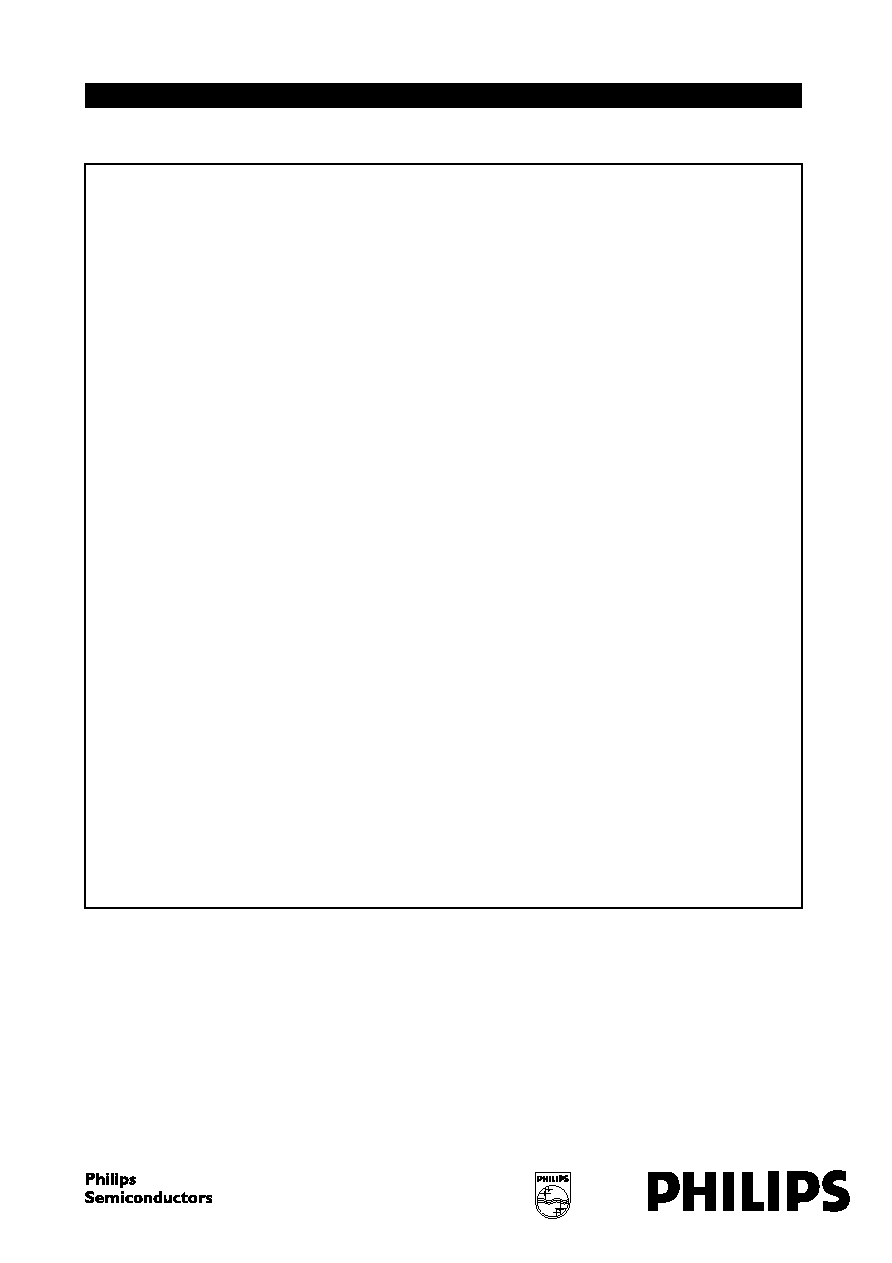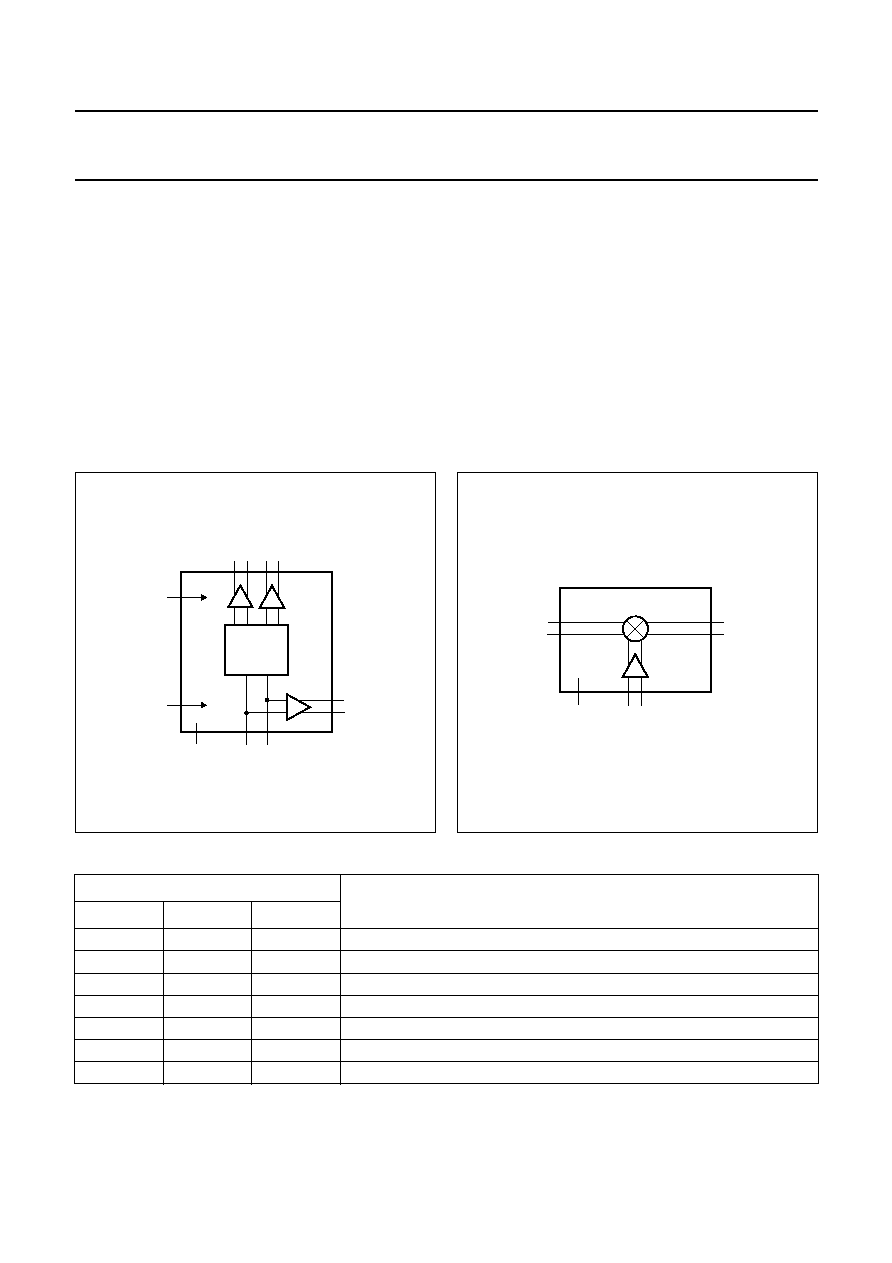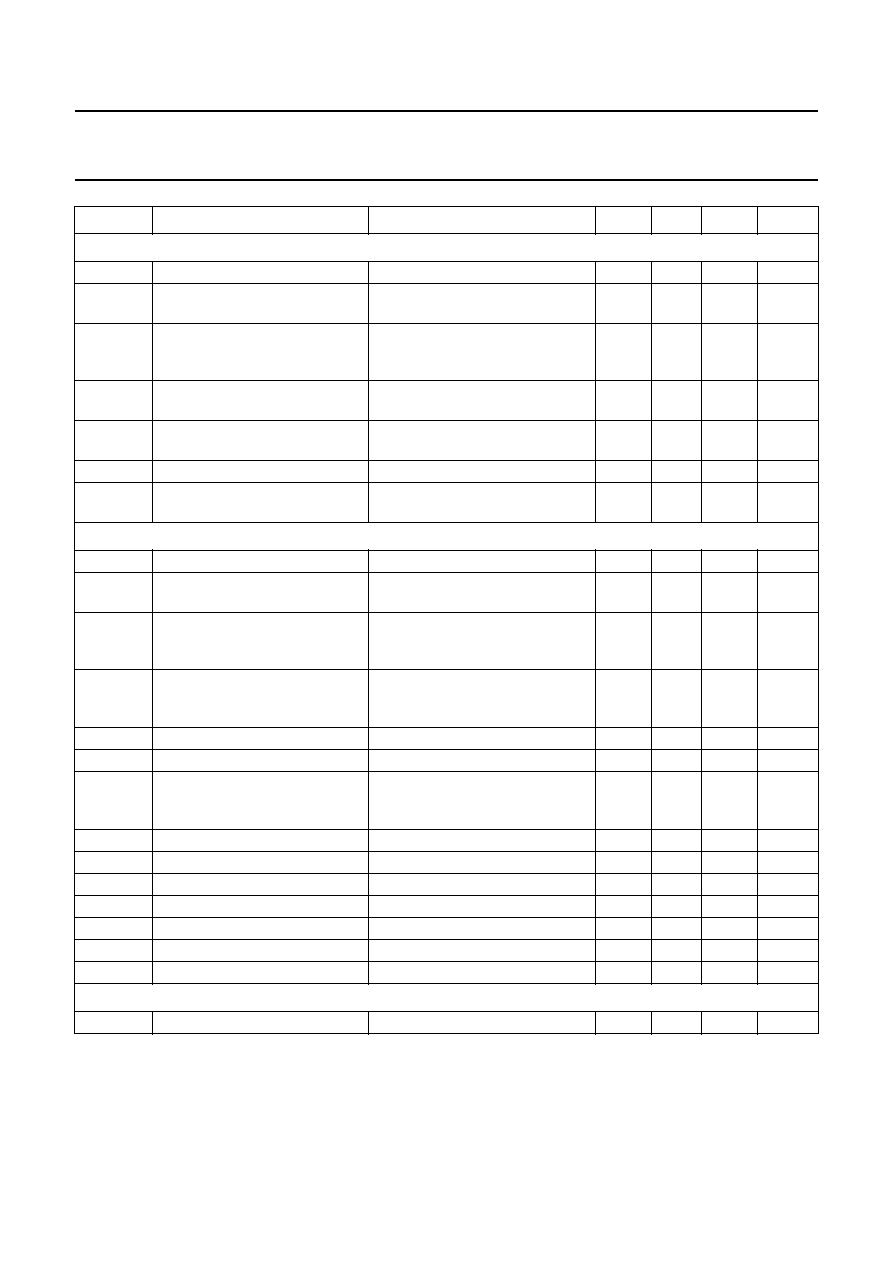Document Outline
- FEATURES
- APPLICATIONS
- GENERAL DESCRIPTION
- QUICK REFERENCE DATA
- ORDERING INFORMATION
- BLOCK DIAGRAM
- PINNING
- FUNCTIONAL DESCRIPTION
- Receive section
- Local oscillator section
- Transmit mixer
- LIMITING VALUES
- THERMAL CHARACTERISTICS
- HANDLING
- DC CHARACTERISTICS
- AC CHARACTERISTICS
- INTERNAL PIN CONFIGURATION
- APPLICATION INFORMATION
- PACKAGE OUTLINE
- SOLDERING
- DEFINITIONS
- LIFE SUPPORT APPLICATIONS

DATA SHEET
Product specification
Supersedes data of 1996 Oct 02
File under Integrated Circuits, IC17
1997 Sep 24
INTEGRATED CIRCUITS
UAA2077CM
2 GHz image rejecting front-end

1997 Sep 24
2
Philips Semiconductors
Product specification
2 GHz image rejecting front-end
UAA2077CM
FEATURES
∑
Low-noise, wide dynamic range amplifier
∑
Very low noise figure
∑
Dual balanced mixer for over 30 dB on-chip image
rejection
∑
IF I/Q combiner at 188 MHz
∑
On-chip quadrature network
∑
Down-conversion mixer for closed-loop transmitters
∑
Independent TX/RX fast ON/OFF power-down modes
∑
Very small outline packaging
∑
Very small application (no image filter).
APPLICATIONS
∑
High frequency front-end for DCS1800/PCS1900
hand-portable equipment
∑
Compact digital mobile communication equipment
∑
TDMA receivers e.g. RF-LANS.
GENERAL DESCRIPTION
UAA2077CM contains both a receiver front-end and a high
frequency transmit mixer intended to be used in mobile
telephones. Designed in an advanced BiCMOS process it
combines high performance with low power consumption
and a high degree of integration, thus reducing external
component costs and total front-end size.
The main advantage of the UAA2077CM is its ability to
provide over 30 dB of image rejection. Consequently, the
image filter between the LNA and the mixer is suppressed.
Image rejection is achieved in the internal architecture by
two RF mixers in quadrature and two all-pass filters in
I and Q IF channels that phase shift the IF by 45
∞
and 135
∞
respectively. The two phase shifted IFs are recombined
and buffered to furnish the IF output signal.
Signals presented at the RF input at LO + IF frequency are
rejected through this signal processing while signals at
LO
-
IF frequency can form the IF signal.
The receiver section consists of a low-noise amplifier that
drives a quadrature mixer pair. The IF amplifier has
on-chip 45
∞
and 135
∞
phase shifting and a combining
network for image rejection. The IF driver has differential
open-collector type outputs.
The LO part consists of an internal all-pass type phase
shifter to provide quadrature LO signals to the receive
mixers. The all-pass filters outputs are buffered before
being fed to the receive mixers.
The transmit section consists of a low-noise amplifier, and
a down-conversion mixer. In the transmit mode, an internal
LO buffer is used to drive the transmit IF down-conversion
mixer.
All RF and IF inputs or outputs are balanced.
Pins RXON, TXON and SXON allow to control the different
power-down modes. A synthesizer-on (SX) mode enables
LO buffers independent of the other circuits. When
pin SXON is HIGH, all internal buffers on the LO path of
the circuit are turned on, thus minimizing LO pulling when
remainder of the receive or transmit chain is powered up.
Special care has been taken for fast power-up switching.
QUICK REFERENCE DATA
SYMBOL
PARAMETER
MIN.
TYP.
MAX.
UNIT
V
CC
supply voltage
3.6
3.75
5.3
V
I
CC(RX)
receive supply current
27.5
36
44.5
mA
I
CC(TX)
transmit supply current
11
14
17.5
mA
I
CC(PD)
supply current in power-down
-
-
50
µ
A
T
amb
operating ambient temperature
-
30
+25
+75
∞
C

1997 Sep 24
3
Philips Semiconductors
Product specification
2 GHz image rejecting front-end
UAA2077CM
ORDERING INFORMATION
BLOCK DIAGRAM
TYPE
NUMBER
PACKAGE
NAME
DESCRIPTION
VERSION
UAA2077CM
SSOP20
plastic shrink small outline package; 20 leads; body width 4.4 mm
SOT266-1
Fig.1 Block diagram.
handbook, full pagewidth
MGD285
LNA
MIXER
IF
COMBINER
low-noise
amplifier
5
3
15
16
6
18
19
20
17
9
1
13
14
2
TXINA
TXINB
LOINB
MIXER
LOINA
4
7
IFA
IFB
TXOA
TXOB
n.c.
n.c.
SXON
10
SBS
12
+
45
o
+
135
o
RXON
11
TXON
QUADRATURE
PHASE
SHIFTER
RFINA
RFINB
8
LNAGND
LOGND
VCCLNA
VCCLO
UAA2077CM
RECEIVE SECTION
TRANSMIT SECTION
LOCAL OSCILLATOR
SECTION

1997 Sep 24
4
Philips Semiconductors
Product specification
2 GHz image rejecting front-end
UAA2077CM
PINNING
SYMBOL
PIN
DESCRIPTION
TXINA
1
transmit mixer input A (balanced)
TXINB
2
transmit mixer input B (balanced)
V
CCLNA
3
supply voltage for LNA, IF parts
and TX mixer
n.c.
4
not connected
RFINA
5
RF input A (balanced)
RFINB
6
RF input B (balanced)
n.c.
7
not connected
LNAGND
8
ground for LNA, IF parts and TX
mixer
SXON
9
SX mode enable (see Table 1)
SBS
10
sideband selection (should be
grounded for f
LO
< f
RF
)
TXON
11
TX mode enable (see Table 1)
RXON
12
RX mode enable (see Table 1)
LOINB
13
LO input B (balanced)
LOINA
14
LO input A (balanced)
V
CCLO
15
supply voltage for LO parts
LOGND
16
ground for LO parts
IFA
17
IF output A (balanced)
IFB
18
IF output B (balanced)
TXOA
19
transmit mixer IF output A
(balanced)
TXOB
20
transmit mixer IF output B
(balanced)
Fig.2 Pin configuration.
handbook, halfpage
UAA2077CM
MGD286
1
2
3
4
5
6
7
8
9
10
TXINA
TXINB
VCCLNA
SBS
n.c.
RFINA
RFINB
n.c.
LNAGND
SXON
TXOB
TXOA
IFB
TXON
IFA
LOGND
VCCLO
LOINA
LOINB
RXON
20
19
18
17
16
15
14
13
12
11

1997 Sep 24
5
Philips Semiconductors
Product specification
2 GHz image rejecting front-end
UAA2077CM
FUNCTIONAL DESCRIPTION
Receive section
The circuit contains a low-noise amplifier followed by two
high dynamic range mixers. These mixers are of the
Gilbert-cell type, the whole internal architecture is fully
differential.
The local oscillator, shifted in phase to 45
∞
and 135
∞
,
mixes the amplified RF to create I and Q channels.
The two I and Q channels are buffered, phase shifted by
45
∞
and 135
∞
respectively, amplified and recombined
internally to realize the image rejection.
Pin SBS allows sideband selection:
∑
f
LO
> f
RF
(SBS = 1)
∑
f
LO
< f
RF
(SBS = 0).
Where f
RF
is the frequency of the wanted signal.
Balanced signal interfaces are used for minimizing
crosstalk due to package parasitics.
The IF output is differential and of the open-collector type.
Typical application will load the output with a 680
resistor load at each IF output, plus a differential 1 k
load
made of the input impedance of the IF filter or the input
impedance of the matching network for the IF filter.
The power gain refers to the available power on this 1 k
load. The path to V
CC
for the DC current should be
achieved via tuning inductors. The output voltage is limited
to V
CC
+ 3V
be
or 3 diode forward voltage drops.
Fast switching, ON/OFF, of the receive section is
controlled by the hardware input RXON.
Fig.3 Block diagram, receive section.
handbook, full pagewidth
MGD754
LNA
IF
COMBINER
IF
amplifier
IF
amplifier
MIXER
MIXER
RXON
LOIN
IFA
IFB
RFINA
RFINB
SBS
LNAGND
VCCLNA
+
45
o
+
135
o

1997 Sep 24
6
Philips Semiconductors
Product specification
2 GHz image rejecting front-end
UAA2077CM
Local oscillator section
The Local Oscillator (LO) input directly drives the two
internal all-pass networks to provide quadrature LO to the
receive mixers.
A synthesizer-ON mode (SX mode) is used to power-up all
LO input buffers, thus minimizing the pulling effect on the
external VCO when entering receive or transmit mode.
This mode is active when SXON = 1.
Transmit mixer
This mixer is used for down-conversion to the transmit IF.
Its inputs are coupled to the transmit RF which is
down-converted to a modulated transmit IF frequency,
phase locked with the baseband modulation.
The IF outputs are HIGH impedance (open-collector
type).Typical application will load the output with a 560
resistor load, connected to V
CC
for DC path, at each TX
output, plus a differential 1 k
made of the input
impedance of the matching network for the following TX
part. The mixer can also be used for frequency
up-conversion.
Fast switching, ON/OFF, of the transmit section is
controlled by the hardware input TXON.
Fig.4 Block diagram, LO section.
handbook, halfpage
MGD287
LOINB
to TX
to RX
LOINA
QUAD
LOGND
VCCLO
SXON
Fig.5 Block diagram, transmit mixer.
handbook, halfpage
MGD153
TXINA
TXINB
TXON
LOIN
TX MIXER
TXOA
TXOB
Table 1 Control of power status
EXTERNAL PIN LEVEL
CIRCUIT MODE OF OPERATION
TXON
RXON
SXON
LOW
LOW
LOW
power-down mode
LOW
HIGH
LOW
RX mode: receive section and LO buffers to RX on
HIGH
LOW
LOW
TX mode: transmit section and LO buffers to TX on
LOW
LOW
HIGH
SX mode: complete LO section on
LOW
HIGH
HIGH
SRX mode: receive section on and SX mode active
HIGH
LOW
HIGH
STX mode: transmit section on and SX mode active
HIGH
HIGH
X
receive section and transmit section on; specification not guaranteed

1997 Sep 24
7
Philips Semiconductors
Product specification
2 GHz image rejecting front-end
UAA2077CM
LIMITING VALUES
In accordance with the Absolute Maximum Rating System (IEC 134).
THERMAL CHARACTERISTICS
HANDLING
All pins withstand 1500 V ESD test in accordance with
"MIL-STD-883C class 1 (method 3015.5)".
SYMBOL
PARAMETER
MIN.
MAX.
UNIT
V
CC
supply voltage
-
9
V
GND
difference in ground supply voltage applied between LOGND and
LNAGND
-
0.6
V
P
i(max)
maximum power input
-
+20
dBm
T
j(max)
maximum operating junction temperature
-
+150
∞
C
P
dis(max)
maximum power dissipation in quiet air
-
250
mW
T
stg
storage temperature
-
65
+150
∞
C
SYMBOL
PARAMETER
VALUE
UNIT
R
th j-a
thermal resistance from junction to ambient in free air
120
K/W

1997 Sep 24
8
Philips Semiconductors
Product specification
2 GHz image rejecting front-end
UAA2077CM
DC CHARACTERISTICS
V
CC
= 3.75 V; T
amb
= 25
∞
C; unless otherwise specified.
Note
1. The referenced inputs should be connected to a valid CMOS input level.
SYMBOL
PARAMETER
CONDITIONS
MIN.
TYP.
MAX.
UNIT
Pins: V
CCLNA
and V
CCLO
V
CC
supply voltage
over full temperature range
3.6
3.75
5.3
V
I
CC(RX)
supply current in RX mode
27.5
36
44.5
mA
I
CC(TX)
supply current in TX mode
11
14
17.5
mA
I
CC(PD)
supply current in power-down mode
-
-
50
µ
A
I
CC(SX)
supply current in SX mode
6.5
8.5
10.5
mA
I
CC(SRX)
supply current in SRX mode
29.5
38.5
47.5
mA
I
CC(STX)
supply current in STX mode
15
19.5
24
mA
Pins: RXON, TXON, SXON and SBS
V
th
CMOS threshold voltage
note 1
-
1.25
-
V
V
IH
HIGH level input voltage
0.7V
CC
-
V
CC
V
V
IL
LOW level input voltage
-
0.3
-
+0.8
V
I
IH
HIGH level static input current
pins at V
CC
-
0.4 V
-
1
-
+1
µ
A
I
IL
LOW level static input current
pins at 0.4 V
-
1
-
+1
µ
A
Pins: RFINA and RFINB
V
I
DC input voltage level
receive section on
1.8
2.0
2.2
V
Pins: IFA and IFB
I
O
DC output current
receive section on
2.3
3.0
3.8
mA
Pins: TXINA and TXINB
V
I
DC input voltage level
transmit section on
1.9
2.15
2.4
V
Pins: TXOA and TXOB
I
O
DC output current
transmit section on
0.8
1.0
1.2
mA
Pins: LOINA and LOINB
V
LOIN
DC input voltage level
RXON, TXON or SXON HIGH
2.6
2.9
3.2
V

1997 Sep 24
9
Philips Semiconductors
Product specification
2 GHz image rejecting front-end
UAA2077CM
AC CHARACTERISTICS
V
CC
= 3.75 V; T
amb
=
-
30 to +75
∞
C; f
oRX
= 188 MHz; unless otherwise specified.
SYMBOL
PARAMETER
CONDITIONS
MIN.
TYP.
MAX.
UNIT
Receive section (receive section enabled)
R
iRX
RF input resistance (real part of
the parallel input impedance)
balanced; at 1960 MHz
-
60
-
C
iRX
RF input capacitance
(imaginary part of the parallel
input impedance)
balanced; at 1960 MHz
-
0.8
-
pF
f
iRX
RF input frequency
1805
-
1990
MHz
RL
iRX
return loss on matched RF input
balanced; note 1
15
20
-
dB
G
CPRX
conversion power gain
differential RF inputs to differential
IF outputs loaded to 1 k
differential
19
22
25
dB
G
rip
gain ripple as a function of RF
frequency
within 100 MHz bandwidth; note 2
-
0.2
0.5
dB
G/T
gain variation with temperature
note 2
-
10
-
15
-
20
mdB/K
CP1
RX
1 dB compression point
differential RF inputs to differential
IF outputs; note 1
-
25.5
-
24
-
dB
DES
desensitisation
interferer frequency offset: 3 MHz;
P
in
=
-
26 dBm; interferer
frequency offset: 20 MHz,
P
in
=
-
23 dBm differential RF
inputs to differential IF outputs;
note 1
-
-
5
dB
IP2D
RX
half IF spurious attenuation for
-
52 dBm input power
(f
RF
= f
LO
+ 0.5
◊
f
IF
)
differential RF inputs to differential
IF outputs; note 2
37
-
-
dB
IP3
RX
3rd order intercept point
differential RF inputs to differential
IF outputs; note 2
-
21.5
-
17
-
dBm
NF
RX
overall noise figure
differential RF inputs to differential
IF outputs
T
amb
= 25
∞
C; DCS frequency
range; note 3
-
3.8
-
dB
T
amb
= 25
∞
C; PCS frequency
range; notes 2 and 3
-
4.0
4.4
dB
T
amb
=
-
30 to +65
∞
C; PCS
frequency range; notes 2 and 3
-
-
5.0
dB
Z
LRX
typical application IF output load
impedance
balanced
-
1000
-
RL
oRX
return loss on matched IF output balanced; note 1
15
20
-
dB
f
oRX
IF frequency range
-
188
-
MHz
IR
rejection of image frequency
f
RF
> f
LO
; f
RF
is the frequency of
the wanted signal
30
38
-
dB

1997 Sep 24
10
Philips Semiconductors
Product specification
2 GHz image rejecting front-end
UAA2077CM
Notes
1. Measured and guaranteed only on UAA2077CM PCS demonstration board at T
amb
= 25
∞
C.
2. Measured and guaranteed only on UAA2077CM PCS demonstration board.
3. This value includes printed-circuit board and balun losses.
Local oscillator section (receive section enabled)
f
iLO
LO input frequency
1617
-
1802
MHz
R
iLO
LO input resistance (real part of
the parallel input impedance)
balanced; at 1770 MHz
-
90
-
C
iLO
LO input inductance (imaginary
part of the parallel input
impedance)
balanced; at 1770 MHz
-
5
-
nH
RL
iLO
return loss on matched input
(including standby mode)
note 1
10
15
-
dB
RL
iLO
return loss variation between
SX, SRX and STX modes
linear S
11
variation; note 1
-
20
-
mU
P
iLO
LO input power level
-
10
-
6
0
dBm
RI
LO
reverse isolation
LOIN to RFIN at LO frequency;
note 2
40
-
-
dB
Transmit section (transmit section enabled)
Z
LTX
TX IF typical load impedance
balanced
-
500
-
RL
oTX
return loss on matched
transmitter IF output
note 1
11
15
-
dB
R
iTX
TX RF input resistance
(real part of the parallel input
impedance)
balanced; at 1880 MHz
-
60
-
C
iTX
TX RF input capacitance
(imaginary part of the parallel
input impedance)
balanced; at 1880 MHz
-
1
-
pF
f
iTX
TX mixer input frequency
1600
-
2000
MHz
RL
iTX
return loss on matched TX input
note 1
10
15
-
dB
G
CPTX
conversion power gain
differential transmitter inputs to
differential transmitter IF outputs
loaded with 500
differential
6
9
12
dB
f
oTX
TX output frequency
50
-
400
MHz
CP1
TX
1 dB input compression point
note 1
-
25
-
22
-
dBm
IP2
TX
2nd order intercept point
note 2
-
+22
-
dBm
IP3
TX
3rd order intercept point
note 2
-
20
-
16
-
dBm
NF
TX
noise figure
double sideband; notes 2 and 3
-
5
9
dB
I
TX
isolation
LOIN to TXIN; note 2
40
-
-
dB
RI
TX
reverse isolation
TXIN to LOIN; note 2
38
-
-
dB
Timing
t
stu
start-up time of each block
1
5
20
µ
s
SYMBOL
PARAMETER
CONDITIONS
MIN.
TYP.
MAX.
UNIT

1997 Sep 24
11
Philips Semiconductors
Product specification
2 GHz image rejecting front-end
UAA2077CM
INTERNAL PIN CONFIGURATION
PIN
SYMBOL
DC
VOLTAGE
(V)
EQUIVALENT CIRCUIT
1
TXINA
2.15
2
TXINB
2.15
5
RFINA
2.0
6
RFINB
2.0
3
V
CCLNA
3.75
8
LNAGND
0
9
SXON
10
SBS
11
TXON
12
RXON
13
LOINB
2.9
14
LOINA
2.9
15
V
CCLO
3.75
16
LOGND
0
MGL205
VCC
GND
2, 6
1, 5
MGL204
VCC
GND
9, 10, 11, 12
MGL206
VCC
GND
13
14

1997 Sep 24
12
Philips Semiconductors
Product specification
2 GHz image rejecting front-end
UAA2077CM
17
IFA
18
IFB
19
TXOA
20
TXOB
PIN
SYMBOL
DC
VOLTAGE
(V)
EQUIVALENT CIRCUIT
MGL207
17
18
VCC
GND
GND
MGL208
19
20
VCC
GND

1997 Sep 24
13
Philips Semiconductors
Product specification
2 GHz image rejecting front-end
UAA2077CM
APPLICATION INFORMATION
handbook, full pagewidth
MGD288
R6
680
82
nH
L11
82
nH
L12
3.75 V
R7
680
5.6 pF
C22
82 pF
C23
5.6 pF
8.2 pF
8.2 pF
C24
IFA
IFB
56 nH
L13
56 nH
L14
C25
12 pF
C26
12 pF
IF
188 MHz
R1
L3
180
nH
L5
120
nH
L2
180
nH
3.75 V
R2
C4
C11
C10
L4
120 nH
C13
C12
12 pF
120 pF
120 pF
22 pF
22 pF
TXOUT
93 MHz
UAA2077CM
20
1
19
2
18
3
17
4
16
5
15
6
14
7
13
8
12
9
11
10
C27
8.2 pF
C28
1 nF
3.75 V
C19
1.5 pF
1.5 pF
C29
C21
1.5 pF
L9
4.7 nH
4.7 nH
C20
LOIN
1742 to 1817 MHz
L10
C9
8.2
pF
2
1
2
1
R5
560
k
RXON
3.75 V
C7
8.2
pF
R3
560
k
560
k
TXON
C8
8.2
pF
2
1
R4
560
k
SXON
SBS
L1
C14
C2
4.7 nH
1.2 pF
1.2 pF
RFIN
1930 to
1990 MHz
L6
4.7 nH
C1
8.2 pF
8.2 pF
8.2
pF
C3
L15
8.2 nH
C6
8.2 pF
C5
82 pF
3.75 V
L7
4.7 nH
C15
1.8 pF
C16
1.8 pF
TXIN
1850 to
1910 MHz
L8
4.7 nH
C18
8.2 pF
C17
8.2 pF
560
560
Fig.6 Application diagram.
Figure
6 illustrates the electrical diagram of the UAA2077CM Philips demonstration board for PCS1900 applications.
For measurement purposes all matching is to 50
. Different values will be used in a real application.

1997 Sep 24
14
Philips Semiconductors
Product specification
2 GHz image rejecting front-end
UAA2077CM
PACKAGE OUTLINE
UNIT
A
1
A
2
A
3
b
p
c
D
(1)
E
(1)
(1)
e
H
E
L
L
p
Q
Z
y
w
v
REFERENCES
OUTLINE
VERSION
EUROPEAN
PROJECTION
ISSUE DATE
IEC
JEDEC
EIAJ
mm
0.15
0
1.4
1.2
0.32
0.20
0.20
0.13
6.6
6.4
4.5
4.3
0.65
1.0
0.2
6.6
6.2
0.65
0.45
0.48
0.18
10
0
o
o
0.13
0.1
DIMENSIONS (mm are the original dimensions)
Note
1. Plastic or metal protrusions of 0.20 mm maximum per side are not included.
0.75
0.45
SOT266-1
90-04-05
95-02-25
w
M
A
A
1
A
2
b
p
D
H
E
L
p
Q
detail X
E
Z
e
c
L
v
M
A
X
(A )
3
A
y
0.25
1
10
20
11
pin 1 index
0
2.5
5 mm
scale
SSOP20: plastic shrink small outline package; 20 leads; body width 4.4 mm
SOT266-1
A
max.
1.5

1997 Sep 24
15
Philips Semiconductors
Product specification
2 GHz image rejecting front-end
UAA2077CM
SOLDERING
Introduction
There is no soldering method that is ideal for all IC
packages. Wave soldering is often preferred when
through-hole and surface mounted components are mixed
on one printed-circuit board. However, wave soldering is
not always suitable for surface mounted ICs, or for
printed-circuits with high population densities. In these
situations reflow soldering is often used.
This text gives a very brief insight to a complex technology.
A more in-depth account of soldering ICs can be found in
our
"IC Package Databook" (order code 9398 652 90011).
Reflow soldering
Reflow soldering techniques are suitable for all SSOP
packages.
Reflow soldering requires solder paste (a suspension of
fine solder particles, flux and binding agent) to be applied
to the printed-circuit board by screen printing, stencilling or
pressure-syringe dispensing before package placement.
Several techniques exist for reflowing; for example,
thermal conduction by heated belt. Dwell times vary
between 50 and 300 seconds depending on heating
method. Typical reflow temperatures range from
215 to 250
∞
C.
Preheating is necessary to dry the paste and evaporate
the binding agent. Preheating duration: 45 minutes at
45
∞
C.
Wave soldering
Wave soldering is not recommended for SSOP packages.
This is because of the likelihood of solder bridging due to
closely-spaced leads and the possibility of incomplete
solder penetration in multi-lead devices.
If wave soldering cannot be avoided, the following
conditions must be observed:
∑
A double-wave (a turbulent wave with high upward
pressure followed by a smooth laminar wave)
soldering technique should be used.
∑
The longitudinal axis of the package footprint must
be parallel to the solder flow and must incorporate
solder thieves at the downstream end.
Even with these conditions, only consider wave
soldering SSOP packages that have a body width of
4.4 mm, that is SSOP16 (SOT369-1) or
SSOP20 (SOT266-1).
During placement and before soldering, the package must
be fixed with a droplet of adhesive. The adhesive can be
applied by screen printing, pin transfer or syringe
dispensing. The package can be soldered after the
adhesive is cured.
Maximum permissible solder temperature is 260
∞
C, and
maximum duration of package immersion in solder is
10 seconds, if cooled to less than 150
∞
C within
6 seconds. Typical dwell time is 4 seconds at 250
∞
C.
A mildly-activated flux will eliminate the need for removal
of corrosive residues in most applications.
Repairing soldered joints
Fix the component by first soldering two diagonally-
opposite end leads. Use only a low voltage soldering iron
(less than 24 V) applied to the flat part of the lead. Contact
time must be limited to 10 seconds at up to 300
∞
C. When
using a dedicated tool, all other leads can be soldered in
one operation within 2 to 5 seconds between
270 and 320
∞
C.

1997 Sep 24
16
Philips Semiconductors
Product specification
2 GHz image rejecting front-end
UAA2077CM
DEFINITIONS
LIFE SUPPORT APPLICATIONS
These products are not designed for use in life support appliances, devices, or systems where malfunction of these
products can reasonably be expected to result in personal injury. Philips customers using or selling these products for
use in such applications do so at their own risk and agree to fully indemnify Philips for any damages resulting from such
improper use or sale.
Data sheet status
Objective specification
This data sheet contains target or goal specifications for product development.
Preliminary specification
This data sheet contains preliminary data; supplementary data may be published later.
Product specification
This data sheet contains final product specifications.
Limiting values
Limiting values given are in accordance with the Absolute Maximum Rating System (IEC 134). Stress above one or
more of the limiting values may cause permanent damage to the device. These are stress ratings only and operation
of the device at these or at any other conditions above those given in the Characteristics sections of the specification
is not implied. Exposure to limiting values for extended periods may affect device reliability.
Application information
Where application information is given, it is advisory and does not form part of the specification.

1997 Sep 24
17
Philips Semiconductors
Product specification
2 GHz image rejecting front-end
UAA2077CM
NOTES

1997 Sep 24
18
Philips Semiconductors
Product specification
2 GHz image rejecting front-end
UAA2077CM
NOTES

1997 Sep 24
19
Philips Semiconductors
Product specification
2 GHz image rejecting front-end
UAA2077CM
NOTES

Internet: http://www.semiconductors.philips.com
Philips Semiconductors ≠ a worldwide company
© Philips Electronics N.V. 1997
SCA55
All rights are reserved. Reproduction in whole or in part is prohibited without the prior written consent of the copyright owner.
The information presented in this document does not form part of any quotation or contract, is believed to be accurate and reliable and may be changed
without notice. No liability will be accepted by the publisher for any consequence of its use. Publication thereof does not convey nor imply any license
under patent- or other industrial or intellectual property rights.
Netherlands: Postbus 90050, 5600 PB EINDHOVEN, Bldg. VB,
Tel. +31 40 27 82785, Fax. +31 40 27 88399
New Zealand: 2 Wagener Place, C.P.O. Box 1041, AUCKLAND,
Tel. +64 9 849 4160, Fax. +64 9 849 7811
Norway: Box 1, Manglerud 0612, OSLO,
Tel. +47 22 74 8000, Fax. +47 22 74 8341
Philippines: Philips Semiconductors Philippines Inc.,
106 Valero St. Salcedo Village, P.O. Box 2108 MCC, MAKATI,
Metro MANILA, Tel. +63 2 816 6380, Fax. +63 2 817 3474
Poland: Ul. Lukiska 10, PL 04-123 WARSZAWA,
Tel. +48 22 612 2831, Fax. +48 22 612 2327
Portugal: see Spain
Romania: see Italy
Russia: Philips Russia, Ul. Usatcheva 35A, 119048 MOSCOW,
Tel. +7 095 755 6918, Fax. +7 095 755 6919
Singapore: Lorong 1, Toa Payoh, SINGAPORE 1231,
Tel. +65 350 2538, Fax. +65 251 6500
Slovakia: see Austria
Slovenia: see Italy
South Africa: S.A. PHILIPS Pty Ltd., 195-215 Main Road Martindale,
2092 JOHANNESBURG, P.O. Box 7430 Johannesburg 2000,
Tel. +27 11 470 5911, Fax. +27 11 470 5494
South America: Rua do Rocio 220, 5th floor, Suite 51,
04552-903 S„o Paulo, S√O PAULO - SP, Brazil,
Tel. +55 11 821 2333, Fax. +55 11 829 1849
Spain: Balmes 22, 08007 BARCELONA,
Tel. +34 3 301 6312, Fax. +34 3 301 4107
Sweden: Kottbygatan 7, Akalla, S-16485 STOCKHOLM,
Tel. +46 8 632 2000, Fax. +46 8 632 2745
Switzerland: Allmendstrasse 140, CH-8027 ZÐRICH,
Tel. +41 1 488 2686, Fax. +41 1 481 7730
Taiwan: Philips Semiconductors, 6F, No. 96, Chien Kuo N. Rd., Sec. 1,
TAIPEI, Taiwan Tel. +886 2 2134 2865, Fax. +886 2 2134 2874
Thailand: PHILIPS ELECTRONICS (THAILAND) Ltd.,
209/2 Sanpavuth-Bangna Road Prakanong, BANGKOK 10260,
Tel. +66 2 745 4090, Fax. +66 2 398 0793
Turkey: Talatpasa Cad. No. 5, 80640 GÐLTEPE/ISTANBUL,
Tel. +90 212 279 2770, Fax. +90 212 282 6707
Ukraine: PHILIPS UKRAINE, 4 Patrice Lumumba str., Building B, Floor 7,
252042 KIEV, Tel. +380 44 264 2776, Fax. +380 44 268 0461
United Kingdom: Philips Semiconductors Ltd., 276 Bath Road, Hayes,
MIDDLESEX UB3 5BX, Tel. +44 181 730 5000, Fax. +44 181 754 8421
United States: 811 East Arques Avenue, SUNNYVALE, CA 94088-3409,
Tel. +1 800 234 7381
Uruguay: see South America
Vietnam: see Singapore
Yugoslavia: PHILIPS, Trg N. Pasica 5/v, 11000 BEOGRAD,
Tel. +381 11 625 344, Fax.+381 11 635 777
For all other countries apply to: Philips Semiconductors, Marketing & Sales Communications,
Building BE-p, P.O. Box 218, 5600 MD EINDHOVEN, The Netherlands, Fax. +31 40 27 24825
Argentina: see South America
Australia: 34 Waterloo Road, NORTH RYDE, NSW 2113,
Tel. +61 2 9805 4455, Fax. +61 2 9805 4466
Austria: Computerstr. 6, A-1101 WIEN, P.O. Box 213, Tel. +43 160 1010,
Fax. +43 160 101 1210
Belarus: Hotel Minsk Business Center, Bld. 3, r. 1211, Volodarski Str. 6,
220050 MINSK, Tel. +375 172 200 733, Fax. +375 172 200 773
Belgium: see The Netherlands
Brazil: see South America
Bulgaria: Philips Bulgaria Ltd., Energoproject, 15th floor,
51 James Bourchier Blvd., 1407 SOFIA,
Tel. +359 2 689 211, Fax. +359 2 689 102
Canada: PHILIPS SEMICONDUCTORS/COMPONENTS,
Tel. +1 800 234 7381
China/Hong Kong: 501 Hong Kong Industrial Technology Centre,
72 Tat Chee Avenue, Kowloon Tong, HONG KONG,
Tel. +852 2319 7888, Fax. +852 2319 7700
Colombia: see South America
Czech Republic: see Austria
Denmark: Prags Boulevard 80, PB 1919, DK-2300 COPENHAGEN S,
Tel. +45 32 88 2636, Fax. +45 31 57 0044
Finland: Sinikalliontie 3, FIN-02630 ESPOO,
Tel. +358 9 615800, Fax. +358 9 61580920
France: 4 Rue du Port-aux-Vins, BP317, 92156 SURESNES Cedex,
Tel. +33 1 40 99 6161, Fax. +33 1 40 99 6427
Germany: Hammerbrookstraþe 69, D-20097 HAMBURG,
Tel. +49 40 23 53 60, Fax. +49 40 23 536 300
Greece: No. 15, 25th March Street, GR 17778 TAVROS/ATHENS,
Tel. +30 1 4894 339/239, Fax. +30 1 4814 240
Hungary: see Austria
India: Philips INDIA Ltd, Band Box Building, 2nd floor,
254-D, Dr. Annie Besant Road, Worli, MUMBAI 400 025,
Tel. +91 22 493 8541, Fax. +91 22 493 0966
Indonesia: see Singapore
Ireland: Newstead, Clonskeagh, DUBLIN 14,
Tel. +353 1 7640 000, Fax. +353 1 7640 200
Israel: RAPAC Electronics, 7 Kehilat Saloniki St, PO Box 18053,
TEL AVIV 61180, Tel. +972 3 645 0444, Fax. +972 3 649 1007
Italy: PHILIPS SEMICONDUCTORS, Piazza IV Novembre 3,
20124 MILANO, Tel. +39 2 6752 2531, Fax. +39 2 6752 2557
Japan: Philips Bldg 13-37, Kohnan 2-chome, Minato-ku, TOKYO 108,
Tel. +81 3 3740 5130, Fax. +81 3 3740 5077
Korea: Philips House, 260-199 Itaewon-dong, Yongsan-ku, SEOUL,
Tel. +82 2 709 1412, Fax. +82 2 709 1415
Malaysia: No. 76 Jalan Universiti, 46200 PETALING JAYA, SELANGOR,
Tel. +60 3 750 5214, Fax. +60 3 757 4880
Mexico: 5900 Gateway East, Suite 200, EL PASO, TEXAS 79905,
Tel. +9-5 800 234 7381
Middle East: see Italy
Printed in The Netherlands
437027/1200/02/pp20
Date of release: 1997 Sep 24
Document order number:
9397 750 02731



















